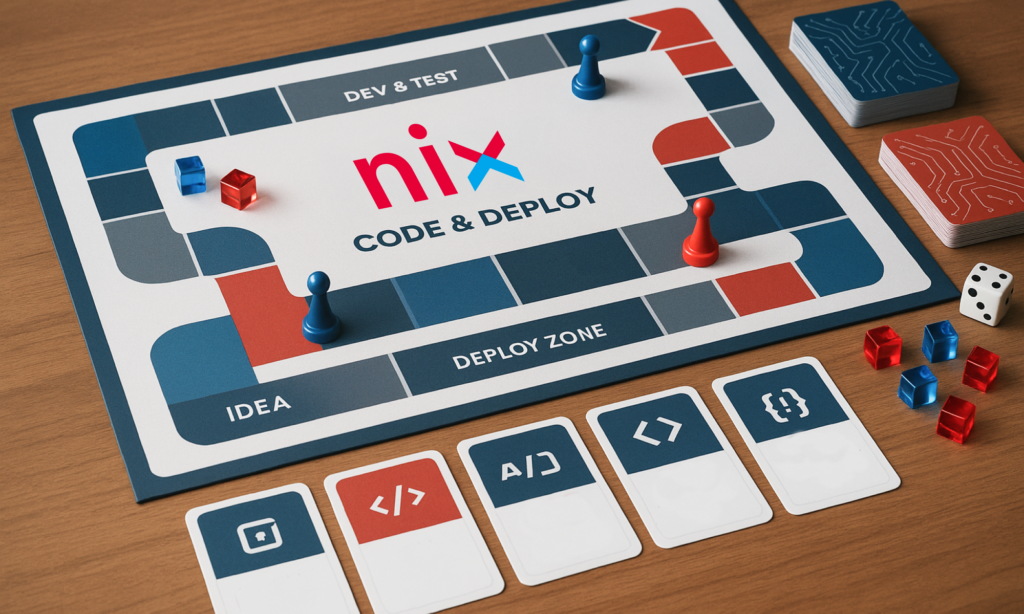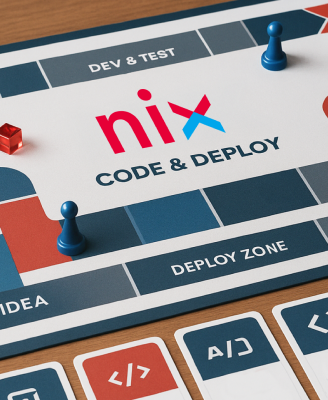Board games are not just about entertainment. They’re also an excellent way to enhance analytical thinking and logic, improve coding skills, and develop other technical abilities for working in IT. You don’t necessarily need to tackle puzzles built on mathematical algorithms. There are other, less obviously useful games for tech people, and NIX experts have compiled such a selection of board games for IT professionals.

New approaches for simplifying routine tasks, a wide choice of roles, and development of soft and hard skills – you’ll gain all of this. These board games for programmers offer unique ways to enhance your technical abilities through games to improve coding skills. So, shall we play?
Cryptid
The game appeared in 2018 and won several awards for its fresh approach to deduction. Cryptid is designed for 3-5 people and 30-40 minute sessions. Players take on the role of cryptozoologists and search for a cryptid – a mythical creature – on a mosaic game board. Everyone has clues that point to the cell where this creature is located. Players take turns making moves, asking each other questions, and based on conditions and constraints from the clues, they come to a conclusion about the cryptid’s location.
How it’s useful in IT
Cryptid thoroughly develops spatial deduction in an unobtrusive yet effective manner. There’s no randomness or bluffing here. Just purely analytical thinking. The game teaches working with constraint intersections. Only one cell on the game board satisfies all logical conditions from the clues. Essentially, the game platform functions as a visual SQL join with WHERE conditions. This can be compared to creating complex queries for targeted database searches or reproducing bugs with unknown variables. It’s one of those games for improving software development skills that focuses on logical problem-solving
Decrypto
This 2018 game ranks 2nd in the party games rating on the BGG portal. Up to 8 people can play Decrypto, divided into 2 teams. Each team receives cards with codes and keywords. Teams take turns choosing a spy who transmits the guessed words through a chain of associations. This should help figure out the code. But you need to do this so that your team “decrypts” the message, but the opponents don’t. It sounds a bit complicated, but in practice everything is simple and dynamic. A game takes 20-40 minutes.
How it’s useful in IT
Decrypto trains multiple layers of analytical thinking simultaneously. First, as a spy, you’re essentially creating ciphers. Your clues must be transparent enough for your teammates while not revealing the underlying logic to opponents. Second, in the role of a decryptor, you develop pattern recognition skills. This parallels finding patterns during reverse engineering, analyzing others’ code, or working with logs when you identify bugs or other application issues through indirect indicators. This makes it particularly valuable among board games for software developers.
Azul
The game was released in 2017, collected dozens of awards, and spawned numerous variations. On the same BGG, it holds 2nd place among abstract games, 15th among family games, and 88th among all available games. 2 to 4 people can play, who for 30-40 minutes become tilers in a royal palace. Their task: create a mosaic from rows of tiles in the form of azulejos – traditional Portuguese tiles. Points are awarded for connections in patterns between tiles by rows, columns, and colors.
How it’s useful in IT
Azul is more than just an aesthetically pleasing game. It teaches algorithmic thinking. You search for optimal patterns and minimize losses when undesirable tiles appear. This requires combinatorial skills and essentially involves implementing a greedy algorithm. The process resembles working with an allocator: resources are limited, requiring careful planning and optimization of their distribution while avoiding penalties. Furthermore, you must recognize patterns within what is essentially a tile layout engine. This skill proves valuable when working with UI and data grids.
Codenames
A cult has already formed around this 2015 game! It has been translated into 38 (!) languages, and themed editions exist for it, for example, Harry Potter or Marvel. The game lasts 10-15 minutes. 2-8 players are divided into 2 teams. 25 cards with words are placed in front of them, among them 5 pieces each are assigned to each team. Only the captain knows these keywords (chosen in turns). Then he points the team to the code words through associations. And you can and should hang several words on such an association so that the team guesses everything faster!
How it’s useful in IT
Codenames shares similarities with Decrypto but operates on different logic. Here, you don’t need to worry about “exposing” your words to opponents. The decryption mechanism is also different: associative rather than deductive, emphasizing creativity. Therefore, the ability to concisely and clearly generalize and express abstract ideas becomes highly valuable. This skill proves essential when naming variables or API methods. It’s also indispensable when explaining concepts to others. For instance, translating from code language to business language.
Terraforming Mars
This 2016 game is considered one of the best in history. In the same BGG rating it occupies 7th place in the overall top! But it should be understood: this strategy for 1-5 players is not for beginners and not for short evenings. It requires special skills and lasts 2-3 hours. During the game, players control corporations on Mars in the 24th century, invest in projects, and transform the planet: raise temperature, increase oxygen and oceans. Whoever most successfully influences Mars wins.
How it’s useful in IT
Terraforming Mars proves particularly valuable for architects, system engineers, product owners, developers, and DevOps professionals at Mid-level and above. The game primarily develops strategic thinking. You create a modular ecosystem, distribute and optimize resources while considering dependencies and constraints, and combine useful cards. This closely resembles managing an IT project: complete with planning, sprints, priorities, and budget considerations. You’re essentially developing a product from MVP to full-fledged application and subsequent scaling.
The Mind
This game became a sensation in 2018. It’s the complete opposite of Terraforming Mars: simple and fast (games last 10-15 minutes). 2 to 4 people can play The Mind. They receive cards with numbers from 1 to 100. In the first round, everyone has 1 card, in the second round 2, in the third round 3, and so on. The task: lay out cards in order. But no one knows who has which numbers and talking about it is forbidden! So you need to intuitively guess when exactly you need to put down the next number. Made a mistake? The whole team loses!
How it’s useful in IT
The Mind doesn’t focus on complex analysis or systems thinking. While you do evaluate probabilities of certain cards in other players’ hands, the game’s main strength lies elsewhere. The Mind significantly improves your ability to read people and achieve non-verbal synchronization. This helps teams act cohesively in a unified rhythm, where everyone understands intuitively when to make their move. These skills form crucial components of successful IT team collaboration, particularly in Scrum environments and remote work settings.
Pandemic
This 2008 game is a classic of cooperative games where players fight together for victory. Pandemic has many newer versions: Legacy, Iberia, On The Brink, etc. But the essence remains unchanged. The team must stop the spread of epidemics on the game board. Each of the 2-4 players has a separate role. For example, the scientist invents vaccines, and the engineer creates equipment for their production. And everyone together must decide what to do at each step: move around the map, extinguish disease outbreaks, develop medicines, etc.
How it’s useful in IT
Pandemic serves as one of the best analogies for collaborative IT project work. First, you analyze and decompose problems, assess risks and resources, and determine priorities. Second, teams must distribute roles and define areas of responsibility. Third, work occurs under uncertainty (players draw random event cards from the deck) and strict time constraints (games last 45 minutes). This requires developing cooperation skills and the ability to quickly adapt, make decisions, and handle pressure. As we say: just like in IT.
Finally, advice from NIX experts: don’t limit yourself to just these games. With the right mindset, opportunities to develop IT-relevant skills can be found in virtually every board game. For example, Carcassonne helps practice modular design, while Ticket to Ride develops system planning under constraints. 7 Wonders allows you to improve decision-making between short-term and long-term goals (similar to sprint planning), and Dixit teaches you to convey complex, abstract ideas to others. Even chaotic games like Exploding Kittens can be valuable. This game requires evaluating explosion probabilities much like estimating potential bug counts after a release.These best board games for developers offer diverse ways to enhance your technical thinking and collaborative skills through games for improving software development skills.





